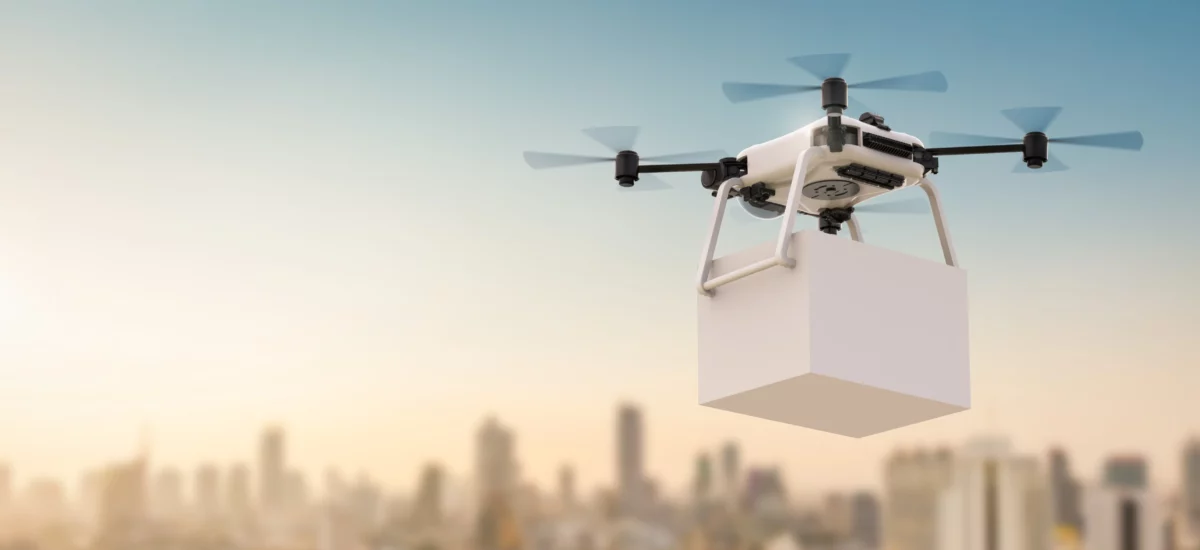Drones: Navigating the Future of Last Mile Logistics

“The last year has been very disruptive and destructive in some ways to a lot of people, but it’s also shed a little light on opportunities. And local last mile deliveries within minutes, not hours, is what we’re talking about. We see a lot of opportunities around rooftop-to-rooftop and moving things in urban spaces, where we get the congestion off the roadways and “greenify” with the reduction of carbon.”
This intriguing vision of our near future was offered by Chris Jarvis, Chief Logistics Officer at GoFor Delivers, speaking with Alan Tay, CEO of Aurora Aerial during a “fireside chat” at the virtual DroneWaves Summit, hosted by FreightWaves.
Aurora Aerial and GoFor are collaborating in the emerging field of drone delivery to provide new options for businesses that will radically improve delivery speed and customer experience.
Here are some highlights from Chris and Alan’s discussion.
How a drone manufacturer got interested in last mile logistics
Alan and his business partner and co-founder of Aurora Aerial are both commercial pilots and very familiar with cargo deliveries. This experience helped them see the opportunity. “We found that the up-and-coming part of the industry was the on-demand portion… I do see a role to offer faster transportation and a greener [approach], and that is why Aurora Aerial was born – to create enterprise [grade] drones capable of delivering that, and most likely even on demand… that is where the future lies.”
Pilot programs around the world are already showing promise
When asked about the current state of drone delivery, Alan mentions several successful pilots, including UPS trials delivering medical supplies and another pilot involving medical supply delivery in Scotland. Alan believes the Aurora and GoFor partnership will have similar success in Canada, but he stresses the need to proceed cautiously and methodically: “We need to crawl, walk, run. We don’t want to be stepping on the expectations of many.”
For the next 2 – 3 years, trials in rural and remote areas will dominate
While the regulatory work is underway to eventually allow drone delivery in urban areas, it’s expected that most trials will take place in less trafficked airspaces for the next few years. According to Alan, “The rural sites, they will be the first to come to [fruition] rather than the urban spaces. As you get into more complex air spaces, there are more stringent rules and safety precautions… That takes a lot more testing and validation and will be about five years out.”

GoFor & Aurora Aerial’s partnership will evolve to include urban use cases
“Over time we’re going to be more urban based,” Chris states. “We’re doing some great, innovative work with mall partners right now, looking at their rooftops, looking at multiple drones being piloted simultaneously rooftop to rooftop, launch pad to driver, driver to home, or directly to the final destination. All four of those use cases and many others are very interesting for us as a last mile service provider.”
No one said it would be easy
For a provider of last mile deliveries, there are a lot of challenges that need to be addressed, as Chris explains: “We’ve got to pilot multiple drones to get the efficiency, so there is one pilot, three drones… and multiple deliveries all in play. [We’re] monitoring, governing, and securing the payload and the drop off, but at the same time we’re a tech-based logistics operator. We do everything in real time… stitching those real-time systems together, integrating and communicating, capturing our proof of delivery, our proof of pick up, and maintaining a chain of custody.”
In the end, it’s all about customer experience
“We have to remember the customer experience of our clients,” Alan says. “We want to make them happy. They want speed, this is what I’m hearing… they want speed, they want to know exactly where their package is [and when it’s going to arrive]. That’s the main thing… we need to stay focused on… because that’s going to drive business.”
Chris also suggests that initially consumers’ interactions with drones could be limited. “A high-powered, noisy drone can be a little bit jarring for customers at times… Let’s go from the retailer to the truck… and reduce that stem mileage. Let the store and the drone be the replenishment channel. The actual driver is the one who does the last hundred feet, and that’s more approachable for the customers.”
Chris believes this model will eventually change as customers grow accustomed to drones and logistics companies get used to navigating tight spaces.
Beyond the last mile, we need to think about the last block
While there has long been a focus on optimizing the last mile of delivery, Chris and Alan also point out the need to think at a more micro scale – what they call the last block. “Local, community-based logistics need to become part of our overall thinking. How do we start to encapsulate very small local solutions?” says Chris. On demand drone delivery could be an important part of these local solutions, including the rooftop-to-rooftop, traffic-beating, carbon-reducing solutions mentioned at the start of this story.
The Bottom Line
For GoFor and Aurora Aerial, this partnership is all about enabling businesses to transform logistics and delight customers with state-of-the-art technology solutions. For more on this relationship, read our news release.
